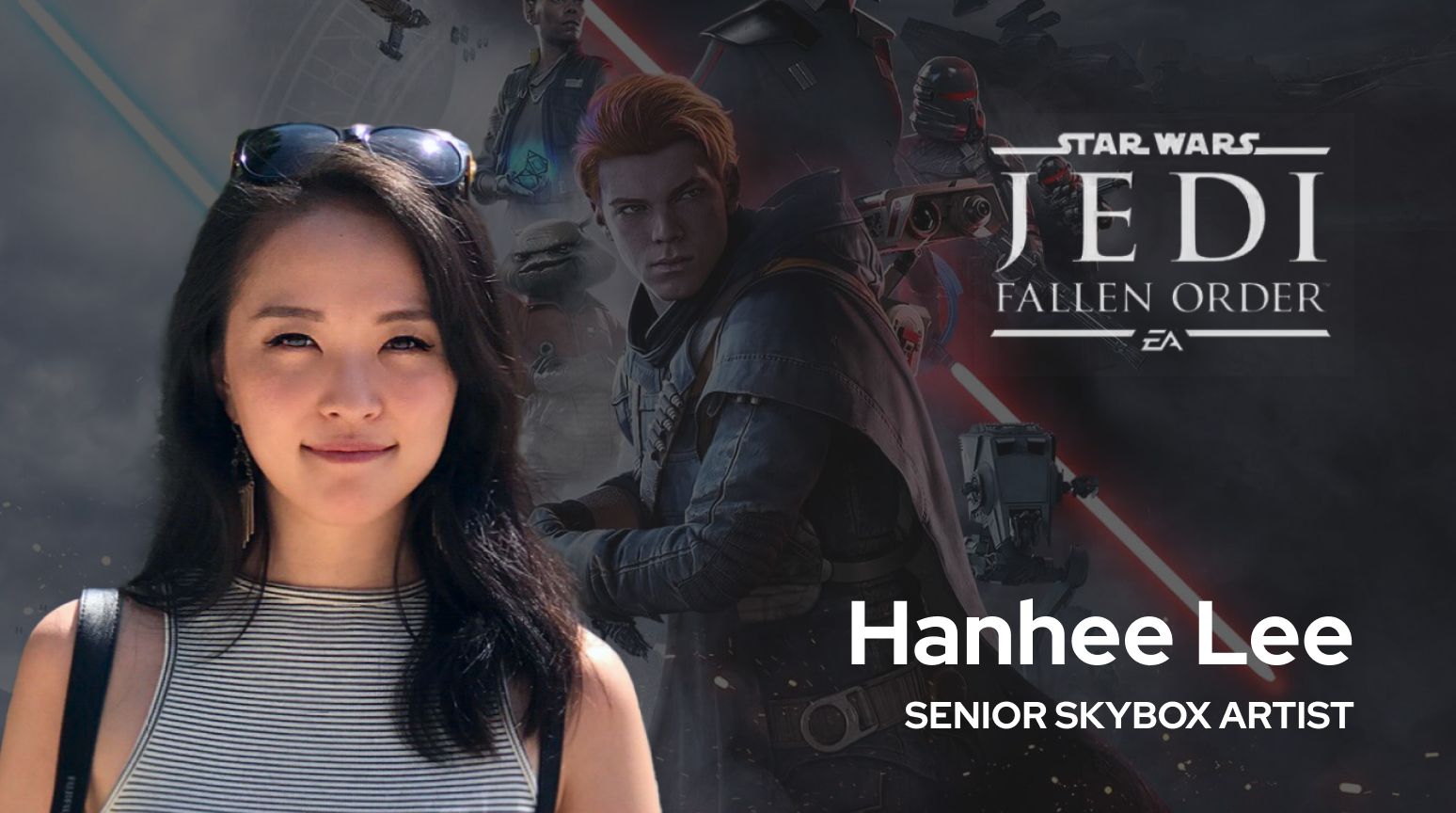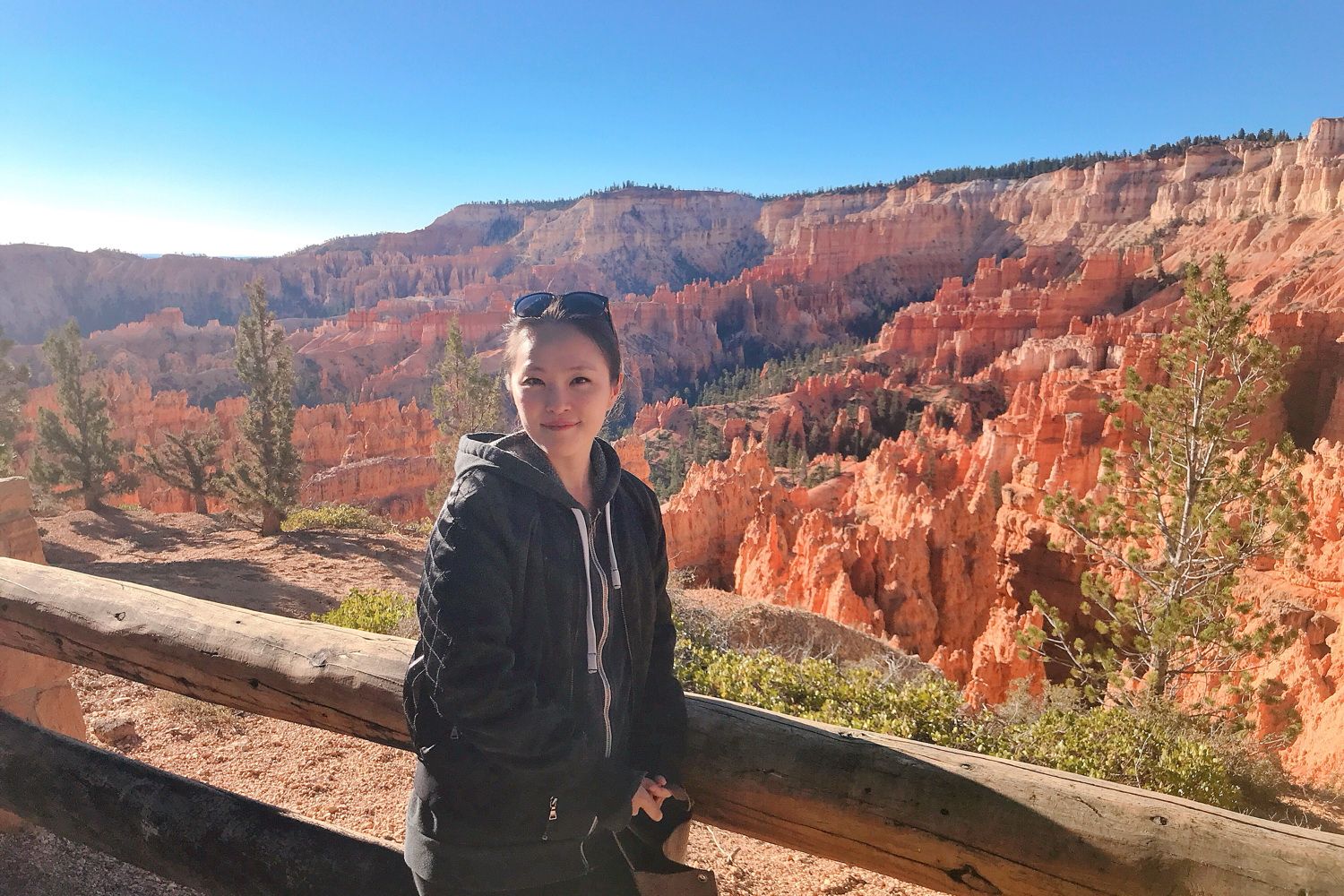Spotlight: Hanhee Lee
Respawn Studios' Senior Skybox Artist Hanhee Lee talks Star Wars Jedi: Fallen Order and more.

Senior Skybox Artist, Star Wars Jedi: Fallen Order
Earlier this year, QuadSpinner's Cynthia Najim sat down with Hanhee Lee to talk about environment art in games, Star Wars Jedi: Fallen Order, and her journey to becoming a top tier environment artist in the industry.
Cynthia Najim: Hi Hanhee! We are excited to learn more about you and your latest mega title Star Wars Jedi: Fallen Order. Before we dive into your projects, please share with us some of your background.
We first met you at our Master Class in Los Angeles back in 2011, when you were a student. What influenced your decision to work in CG? Have there been any surprising twist and turns along the way?
Hanhee Lee: There were twists and turns from the start - including what career to pursue. My first choice was to follow a more intellectual path, like becoming a diplomat. However, when I left Korea and moved to the U.S. for high school, my good grades suffered because I didn’t know English.
During class, I drew characters. My dad thought I was good. Given my grades and the extreme realist that he was, he suggested that I study art. Up until then, I had regarded art as just a hobby, so I resisted saying, “Artists don’t make money! Art is only a hobby!” Then he mentioned Disney and Pixar CG. I was a big fan of their movies, so I thought, “Why not?”

Honestly, even after deciding to pursue CG, I wasn’t sure what I really wanted to do or how to go about doing it. While in college, I changed my major 3 times! I started with a 3D major focused on modeling. Next, I switched to VFX, specializing in matte painting after a friend introduced me to that niche. When the film industry became unstable, I reevaluated that decision. Around that same time, the school opened a Game major. My dad had been gamer since I was young, and I was a gamer myself. So in the end, with just one year left to graduate, I “unofficially” changed to a Game major. I only had two units left to take any game classes in just one year. So I had to study on my own and look for tutorials online to eventually create a portfolio piece.
Every step of the way there were surprises. I realized that I didn’t really enjoy the field I decided to study. I discovered that some industries can be tougher than others. I realized that other areas interest me more and that I must make bold decisions. Learning 3d modeling, matte painting, and game art gave me the opportunity to not just be a 3D environment artist, but also a skybox artist, a position I didn’t even know existed until I joined the industry. Surprise!
CN: Wow, Hanhee, that’s an incredible story! Your willingness to change and your ability to adapt and quickly alter your course are admirable qualities. And they are vital ingredients to success.
Earlier in your career, you worked on the films Valiant and Advantageous as a matte painter. What were the most valuable lessons that you learned from each project? How did they shape your perspectives and onward career choices?
HL: Both were indie films that I participated in during college. We wanted to work like we would work in the real industry. We were managed by professors from major film companies. I remember the whole production was very strict and the schedules were tight. I worked alongside rotoscopers, and most of us stayed up late at night. More than it being our own creation, it felt like we were creating someone else’s vision and we were a small part of the process. I think this experience influenced my later decision to switch from films to games. It was a cool experience, but it wasn’t for me. I’m glad I got to learn that early on in my career.

CN: Congratulations on Star Wars Jedi: Fallen Order, praised as the best Star Wars game to come out in the last decade! What levels did you work on and what were your responsibilities?
HL: Thank you! I am really glad the game did well. I worked on the project as a senior skybox artist. It’s easy if you can think like a matte painter and an environment artist, mainly focusing on scenery sections in the game. My responsibilities included creating skies and vista assets. For Dathomir and Fortress, I created the skies. For Ilum and Bracca, I created the skies and vistas. I also worked on a couple cinematics scenes and planets.
CN: What role did Gaea play?
HL: Many levels need a wide scenery skybox, which often cannot be created just by sculpting. That’s when I use programs that help me create terrains, and Gaea is one of them. While I was working on Star Wars Jedi: Fallen Order, Gaea was still in the early stages of development. However, I wanted to test it out as soon as possible so I could implement it in my pipeline. As a test, I was able to create vista assets for Ilums. Gaea was great - it produced the results I wanted with fewer nodes and realistic outputs. I look forward to creating even more complex terrains with Gaea.
CN: What was your general workflow for creating these terrains? Which tools or features in Gaea were the most useful?
HL: My approach on every level can be slightly different, depending on the art direction and the type of terrain. Usually I create rough blockouts in Unreal and then do a paintover to decide what composition I want to go with. Depending on the terrain types, I start with a terrain program first, such as Gaea, and then do sculpting over if necessary. Or I start with sculpting programs and then take it into terrain programs to add more features over it.
There are many tools in Gaea that are useful, so many in fact that it’s hard to pick! I will say that the Fold node is my favorite, as it creates an extremely interesting output in a single node. The Mask node’s painting ability is a great time saver as well. I also enjoy creating diffuse textures with Gaea as I have multiple nodes to get diverse textures.
CN: Which challenges on this project were most easily solved with Gaea?
HL: My challenge in creating terrain assets in a terrain program is having unique and interesting erosion. Gaea offers many nodes that can diversify the looks of erosion, which is very helpful especially when I need to create skyboxes with very different looks.

CN: Procedural design and art direction can be a tricky balance to maintain. How do you integrate art direction into your terrain workflow? Any specific anecdotes you can share with your fellow node wranglers?
HL: In my opinion, for the best terrain workflow, don’t hesitate to jump between programs to take advantage of each program's features. For one of my past projects, I was expected to create mountains one-to-one with the concept art I received. Similar terrains weren’t acceptable - they had to be exactly the same up to the ridge shapes. It was nearly impossible to create it in a procedural program without spending too much time on it (at least with the tool I used at that time). So I roughly sculpted the shape first and then brought it into a terrain program.
Earlier in my career I preferred starting and finishing terrains only in the terrain programs; however, some terrain features cannot be created with heightfields. So I started mixing sculpting and terrain programs, which gives me the greatest flexibility.
CN: Previously you worked on Halo 5: Guardians, Shadow Realms, and Middle-Earth: Shadow of War. Has your workflow changed since working on these titles? If so, how?
HL: My workflow hasn’t changed too drastically, but I do find the need to jump around to different programs a lot more as I am creating more diverse terrain shapes. Some terrains need more sculpting, while others can be created entirely in terrain programs. Before, I wasn’t able to blend between sculpted areas and procedurally created areas, because it’s challenging to find that ideal balance of details. Now, however, having worked on different projects and learning more along the way, I have a better idea of how to mix them and use more tools to get the results I want.
CN: You used Gaea's predecessor GeoGlyph on Middle-Earth: Shadow of War. What was the experience of moving from GeoGlyph to Gaea?
HL: GeoGlyph was a huge part of my workflow in creating terrains. The nodes in GeoGlyph saved me a lot of time. I was able to create more complex shapes with fewer nodes.
Gaea is a much better software. It has many of the features that help achieve diverse shapes. I find the options to add fog and different lighting angles in the viewport to be very informative. And finally having the option to “Undo” and being able to paint masks with different opacities save a lot of time.

CN: Which are your favorite real-world environments and why? What is your preferred way to prepare for a specific environment project? Do you study nature in the field, consume reference materials, or other methods?
HL: There are so many places I haven’t been to, and I know my favorite real-world environment can change. At the moment, my favorite environment is Iceland, despite the fact I haven’t been to Iceland yet! What is fascinating to me about Iceland is that this small island has so many biomes - just like game environments: sands, lavas, glaciers, greens, and more.
My preferred way to prepare for a specific environment project is not too different from anybody else. I look at reference images and videos to get an idea of the shapes and the vibe. I have also started to learn more about the history of the environment. Watching documentaries on specific places helps me understand how the erosion was formed and why it looks certain ways. Terrains can look different in every part, despite its essential organic shapes. When I understand the main characteristic of the terrain, I can make it look coherent and more believable.
CN: What are your sources of inspiration? How do you keep your work fresh?
HL: I draw inspiration from multiple sources, including other artists and nature. Encountering dramatic skies and beautiful scenery is always inspiring. Traveling is one of my favorite ways, but unfortunately that’s on hold during this pandemic. For now, going on scenic drives or watching documentaries of amazing places can be good substitutes. And of course, seeing other artists’ work on the internet is also very inspiring.
Having a husband who is a veteran artist in the industry helps me stay motivated and keep my eye fresh. We constantly bounce ideas off each other. We can also be a harsh critic.
I also keep my work fresh by rotating different types of work. Luckily, skybox not only involves sculpting and texturing, but also matte painting and node wrangling with terrain programs, which makes the workflow not so boring and repetitive.
CN: How do you measure the success of your contributions to a project?
HL: There are multiple factors that help me measure the success of my contributions to a project. Because skybox covers such a huge area in most of the levels, it ends up influencing the mood, vibe, and often the scale of each level (how far the distance stretches). I mainly consider how effectively my skybox helped develop those elements for each level. Other factors include how happy am I with the result, how my colleagues see my work, and how players react to my work.

CN: All professional artists face the need to get the job done no matter what! What is the weirdest or most unorthodox thing you have had to do to finish a job?
HL: On one project, we found out at the end that we had to bake the lights onto my vista meshes that were already placed in the engine. It had countless mountains in it! I had to UV every single vista mesh in the level and make a UV sheet to let the lighter bake the lighting as a texture. Then I had to paint over those textures to add back details. Even worse is that I had more than 6 sets of different lighting baked in it, so I had to re-paint all of those. Had I known in advance; I would have just done a matte painting. This can happen when the pipeline has not been set. Now I try to determine early in the project if it’s better to create a matte painting, so this won’t happen again.
CN: You have worked in some top studios. What are some of the most valuable lessons you have learned since your first job in games?
HL: Each studio and team have a different culture, different workflow, and even use different programs. Whether big or small, each studio has pros and cons. The great part about working in a variety of studios is that you can observe what works well and what doesn’t, work-wise and behaviorally. It sounds a bit cliché, but I didn’t feel it by heart until I experienced it.
One of the first things I learned from my seniors is that it’s best to not be attached to my work. That's not always easy, but it gets easier. Nowadays I gladly move on and redo or make changes. It often forces me to produce something new, which can result in better outputs. No one likes wasting their time, but it is just a game after all. This doesn’t mean I shouldn’t care about my work. It's actually a reminder that I don’t need to kill myself to get the work done. When one of my leads used to say that, I didn’t get it. We artists are all perfectionists in some ways. I noticed that I was obsessed about getting my work up to the bar I was happy with - something not easily done, especially during crunch times - but I used to do it. Unfortunately, there is often a price for that, like sacrificing one’s health. Balance is key.
CN: What have been your experiences as a woman in a predominantly male industry?
HL: There have been a few bumps along the way, but overall, it has been great for me. Perhaps that’s because I was more of a tomboy as a kid. In general, I feel like people in the game industry are more innocent and fun, making them easy to work with. I have certainly had my fair share of harassment in the industry since I started. My sense is that those situations had less to do with the fact that our industry is predominantly male, and more to do with individuals who don’t know how to act or behave properly, stemming from their own personal issues. You can meet those people in any industry. Except for those encounters, all other male coworkers have been very considerate and respectful. I think these issues become greater when the people who are being told of these problems decide to look away. I sense that companies are taking these matters a lot more seriously now, which is good.
I can’t speak for other women, but I just want to be treated as a fellow game developer. While there are definitely some toxic cultures, I am fortunate because I don’t feel that I’m treated differently, positively or negatively, because I am a woman.

CN: Is there anything that you now know about the industry that you wish you knew at the start?
HL: Well, I do wish I had all the skills back then that I’ve acquired now. :D Beyond that, it's hard to say. We’re bound to get more lemons along the way in life. Haha. And compared to when I began, I have more lemons now. My eyes were sparkling when I first started in the business. That excitement early on, just like with everyone else, made me overwork. Everything was about my career. I didn’t care as much about other things. I was obsessed about getting my tasks done perfectly. This mindset really burned me out in some projects. My lead at my first job told me, “It’s just another texture in this whole game. You don’t need to make it perfect”. Instead of trying to understand that, I took it as a challenge. LOL. I don’t think I succeeded in that challenge. I would still do the same if I had to go back and do it again.
Things have normalized, which is good because I can see things more clearly. lol. I am happy now. I know how to balance life and work better. Working is still my hobby, but it’s not everything. Oh, and working out is very important. The longer you’re in the industry, the harder it gets to lose that belly.
CN: What’s next for you? Any projects you can share?
HL: I’ll be working on more personal projects, still WIP. Will be glad to share later! :)
CN: Thank you, Hanhee! Very illuminating. We look forward to following your onward success. :)
HL: Thank you! This interview made me look back at my career and realize once again how fortunate I am to be in this industry working alongside great people on great projects.
Explore Hanhee's work at HanheeLee.com and her ArtStation portfolio.
Thanks to Respawn Entertainment and Lucasfilm Ltd. The images in this interview are reproduced here with permission for informational use.

